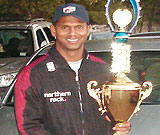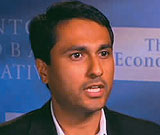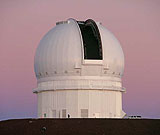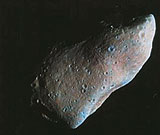|
UP/BIHARI DIASPORA
|
 GUYANA
GUYANA
|

Shiv Chanderpaul is endorsing the first ever American College Cricket Spring Break Championship to be held on March 19-22, 2009 at the Central Broward Regional Park in Lauderhill, Florida.
The 2008 ICC Cricketer, Chanderpaul has endorsed the tournament and provided the trophy, which will be awarded to the winner of the championship.
“It’s a great honour to have the world’s number one batsman supporting the championship. This will be an incalculable boost to American cricket. Our members are fired up and will compete very hard to be the team taking the Chanderpaul Trophy home,” said Lloyd Jodah, president of the American College Cricket
College cricket clubs from across the US will compete in the championship.
Teams from Yale , USC, Boston University, Michigan State, Rutgers, Temple University, Ole Miss, Montgomery College (in MD), Boise State, University of Miami and University of Illinois have expressed interest in participating.
Spring Break will take on a new meaning for the young cricket players who will travel to South Florida to take part in this ground breaking event.
The format of the game will be the highly popular Twenty/20, lasting three hours. American College Cricket is an organisation fully committed to the development and promotion of college cricket in the US.
|
|
BENGALI DIASPORA
|
 US
US
|
|
Mani Bhaumik has been chosen as the sole patron for the International Year of Astronomy (IYA) 2009.
The International Astronomical Union (IAU) and the United Nations Educational, Scientific and Cultural Organization (UNESCO) are observing 2009 as the International Year of Astronomy to celebrate the 400th anniversary of Galileo Galilei’s astronomical telescope.
Announcing his appointment the IAU said: “Dr Bhuamik is a physicist, internationally bestselling author, celebrated lecturer, entrepreneur, and a philanthropist. He is a laser physicist who announced the successful demonstration of the world’s first efficient excimer laser.”
|
|
SINDHI
DIASPORA
|
 US
US
|
|
Ajay Khetani, the Anaheim City Commissioner, has been conferred the Hind Ratan Award 2009 at a function in Delhi by the NRI Welfare Society of India.
Khetani was born and raised in Mumbai and belongs to an illustrious family of freedom fighters and businessmen.
Khetani graduated engineering from Baroda and moved to the US. He did his masters and worked with Mitsubishi, then in 1990 changed professions to real estate and financing and is now a leader in his field in Southern California. The advisory board of the NRI Welfare Society of India comprises several leading personalities, including former PM H.D. Deve Gowda, former election commissioner V.G. Krishnamurthy and Union minister Sushil Kumar
Shinde.
|
|
GUJARATI
DIASPORA
|
 US
US
|

Eboo S. Patel, founder executive director of the Chicago based Interfaith Youth Corps, has been named to the 25 member Advisory Council of US President Barack Obama, which is composed of religious leaders and scholars from various backgrounds.
The Interfaith Council will focus on making community groups an integral part of the US economic recovery, and beyond America an office will work with the National Security Council to foster interfaith dialogue with leaders and scholars around the world.
Patel, 33, founded Interfaith Youth Corps in 1998, with the overarching goal of encouraging mutual respect and pluralism among young people from different religious traditions, by empowering them to work together to serve others.
Patel and the other advisors met Obama for a half-hour meeting in the Oval Office on February 5.
Patel said his goal was to “operationalise the process of training a generation of interfaith leaders”, largely in the manner of his own organisation. IFYC staff travel to college campuses and make presentations to recruit young people into becoming interfaith leaders.
Cassim Salojee, a South African freedom fighter of Indian-origin, has died after a brief illness in Johannesburg.
The 74-year-old member of parliament, whose parents migrated to the African nation in the 1920s, was arrested in the 1980s and charged with treason along with 14 other activists. He played an important role in the liberation struggles against Apartheid in South Africa from 1970s to the early 1990s. He was elected to the parliament by the ANC in 1994 and had remained a member of parliament since then. Salojee became president of the Transvaal Indian Congress after it was revived in 1980, and became an active member of the United Democratic Front in the 1980s.
|
|
|
ANDHRA
DIASPORA
|
 US
US
|

University of North Dakota graduate student Vishnu Reddy has received an official okay from the International Astronomical Union to name an asteroid he discovered “North Dakota”, says a report in India West.
Asteroids are small rocky bodies found especially between the orbits of Mars and Jupiter.
Reddy, who has discovered 18 main belt asteroids, several binary asteroids (twin asteroids), and a supernova, “has built an international reputation for his ongoing research and discoveries,” according to the university.
Just how the 31-year-old graduate student braved skepticism, lack of funds, Indian bureaucratic red tape, and an Arizona monsoon and reached his goal with help from unexpected quarters is in itself quite a story.
Reddy had a passion for astronomy since childhood. Perhaps it was the town he grew up in, Sriharikota, from where India launches its satellites that triggered his imagination. That passion stayed with him when he was a journalist with the Asian Age daily in New Delhi.
In 2000, University of Arizona astronomy expert Tom Gehrels came to give a talk at the local planetarium.
After the talk, Reddy pressed Gehrels for an interview. During the conversation, Gehrels said that while hundreds and thousands of asteroids had been discovered, no Indians were part of the process.

“I said, ‘Tom, I am going to do this,’“ Reddy recalled.
Gehrels said, “You know Vishnu, a lot of Indians said they would study asteroids and they never did. I don’t trust you at all.” Reddy got upset. “How can this guy just dismiss like a billion people?” he recalls.
His first hurdle was getting a proper telescope. The right telescope cost at least Rs 10 lakh. He didn’t have that kind of money.
“So what do you do? You go to the rich relatives,” he said. “Everybody in my family except me is a medical doctor.” Reddy’s two sisters and parents were doctors.
Not that it helped. “While I am sitting here making money he is just looking at stars,” said his father.
Fortunately for Reddy, a sympathetic colleague at the Asian Age’s features department, Pratibha Kumar, was also interested in astronomy, and her father, a retired government official, offered financial support.

A retired air force pilot from Southern California bought him the telescope, and Reddy managed to pay him back. But Indian customs slapped hefty import duties, and it was three years before Reddy could lay his hands on the scope. By then all the asteroids that could be discovered with that telescope were long discovered.
Fortunately, his Internet friends from the US came to his rescue. A friend in Arizona told him he didn’t use his observatory in July, so Reddy was welcome to use it then.
Reddy finally arrived in the US. “This random guy in Michigan, he wanted to help me discover this asteroid,” Reddy recalled. The man delivered pizza and was an amateur astronomer. “He put me and the other friend of ours in his house for three months. Can you beat that? I never met this guy ever in my life!” On July 4, 2002, he discovered his first asteroid, which Reddy named Bharat. The second asteroid he named North Dakota. He went on to discover 22 asteroids. After Reddy discovered his first asteroid, he went on to meet Tom Gehrels, the professor who had been dismissive of Indians ever discovering an asteroid. “The guy fell off out of his office chair,” Reddy recalled.
|
 SINGAPORE
SINGAPORE
|
|
Krishna V. Palem, Professor of Rice University and director of the Nanyang Technological University, Institute for Sustainable Nanoelectronics, Singapore, has developed a microchip, seven times faster and uses 30 times less energy than the best that current technology has to offer.
Called the Probabilistic Complementary Metal-Oxide Semiconductor, Palem says for consumers it could mean the difference between charging cell phones every few weeks instead of every few days and will be suited for computer graphics. He says in streaming video applications on a cell phone it is unnecessary to conduct precise calculations. This is in contrast with today’s silicon transistors that are increasingly noisy as they get smaller.
Palem is optimistic about Pbit-chip prospects for artificial eyes and ears in both robots and people. Computers are notoriously inept at recognising even simple objects such as chairs, let alone faces. Probabilistic chips might be able to learn to do a better job. “They could also help improve impaired human vision and hearing.”
Business Week says, “If that chip checks out, it could kick-start a new silicon revolution.”
|
|